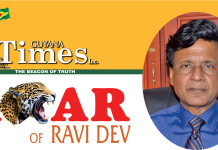1964 marks a rupture in the history of Guyana, and, more specifically, the history of the relations between African and Indian Guyanese, which needs to be bridged. While there had been several clashes between the two groups, these were localised events before that year. With the introduction of the CIA in 1961 — to remove the PPP by “any means necessary” — the confrontation between the two competing political parties, the PPP and the PNC, rooted in the Indian and African communities respectively, spun out of control.
It segued from “sweeping out the PPP with brooms” in 1961 elections, through the burning and looting of Indian businesses in Georgetown on Black Friday, Feb 16, 1962; and the spread of tit-for-tat ethnic violence and arson across the Demerara Coast. The culmination was the pogrom against Indians of Wismar-Christianburg on May 25-26, when 220 Indian homes were razed, three Indians were murdered, several women and girls were raped, almost the entire Indian population of 3000 were forced to flee, and the explosion on the Son Chapman on July 7, which killed 43 of the all-African passengers headed towards Wismar. The killing of five more Indians who had returned or stayed behind at Wismar was almost an anti-climax.
When we “look back at history,” we can only do so from our present; in which questions are posed for answers sought. For me, one question has been how and why the history of the Indians of Wismar, with its denouement of May 26, 1964, has been so completely “silenced”, in the sense of the word used by Rolph Trouillot:
“…the presences and absences embodied in sources (artifacts and bodies that turn an event into fact) or archives (facts collected, thematized, and processed as documents and monuments) are neither neutral nor natural. They are created. As such, they are not mere presences and absences, but mentions or silences of various kinds and degrees. By silence, I mean an active and transitive process: one “silences” a fact or an individual as a silencer silences a gun. One engages in the practice of silencing. Mentions and silences are thus active dialectical counterparts of which history is the synthesis.”
But we simultaneously, from our present, have our eye on our future – a future we hope to create with the knowledge gleaned from the past. For me, it is a future in which all Guyanese can live in peace, to create their progress and not be manipulated to a return of that past.
But there has also been a rupture with the silencing of the history of the period, and it needs to be rectified if for no other reason than for allowing the survivors of those events to express their grief about their experiences. It is quite possible that the reason for the silence about the period may be because the political leaders “wanted to move on”; but in the new millennium, there were some who evidently thought otherwise.
One such person is President David Granger, who referred to the inter-ethnic violence of the 1960s as the “disturbances” and “the troubles”. In a 2003 paper, without ever mentioning the preceding Wismar atrocities, he wrote, “The most alarming slaughter of the ‘Disturbances’ was that of 40 Africans on 6 July at Huradaia, in the Demerara River, as they travelled in a motor launch to Mackenzie.”
The following year, a “Son Chapman Tragedy Commemoration Committee”, with the PNC integrally involved, organised a 40th Anniversary event at the fatal spot at Huradaia on the Demerara River. Robert Corbin, leader of the PNC, said, “A nation that fails to record its history is bound to make the same mistakes.”
After Granger became the leader of the PNC, he attended the now annually observed Commemoration ceremony in 2011, and declared he wished more people would converge at the spot. The Motto on the Monument at Hurudaia declared: “Those who forget the lessons of history do so at our own peril.”
In 2013, Granger and the PNC initiated moving the commemoration to the centre of Linden, so the people there “would not forget”. When the PNC took office, they would construct the monument, he promised. (To be continued)









